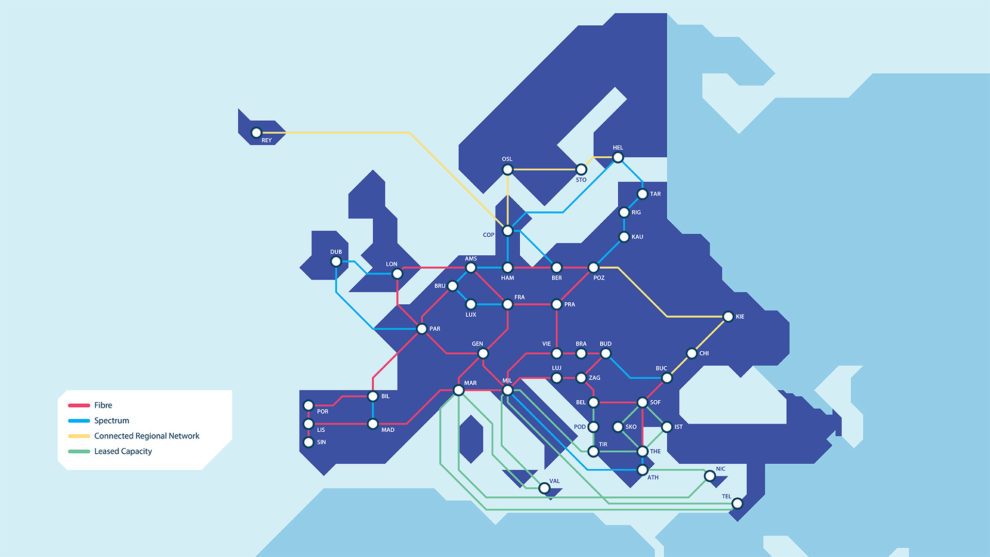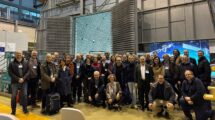GÉANT’s exciting next-generation network – planned, procured, and being built under the EC-funded GN4-3N Project – is very much coming to life in 2022. Driven and guided by the community throughout thanks to the Network Infrastructure Advisory Committee (NIAC), the new network is set to benefit all of Europe’s research and education networking community.
Words: Paul Maurice and Karl Meyer, GÉANT | First part in a series of interviews on the GN4-3N Project. Part 2 here.
With 28 routes deployed (and 14 of those now in operation) two routes in deployment, 12 routes in the connectivity delivery phase, seven routes in the response evaluation or contract finalisation stage, and two routes in the active tendering phase, it’s easy to see how quickly this complex project is moving.
Despite the challenges of the pandemic and its impact on travel, and despite a global semiconductor shortage affecting the delivery of new equipment, everybody involved in this project is continuing to dig deep and push this ambitious and complex project forward.
At the time of writing (early May) 18 countries are now connected to the new network, there are 209 physical spans, with 294 new Infinera nodes built, and over 14,500km of dark fibre has been lit.
In parallel to this work, the focus over the summer will be on the decommissioning of legacy equipment and the migration of new routes, ensuring operational savings are realised and the project budget optimised.
Ahead of its showcase at TNC22, CONNECT spoke to several of the people involved in this project to understand the background and the technical side of the project, but also to see how far we’ve come, what’s coming next, and what the community can expect from the next-generation GÉANT network.
Karl Meyer spoke with Sebastiano Buscaglione, GÉANT’s Senior Network Architect, to understand the process and the technology behind the GN4-3N Project.

Sebastiano, I know this plan has been underway for a long time but how long have you been working on GN4-3N?
Well, the initial pre-planning and design studies started in 2017, so over four years ago. As with all plans of this size there is a huge amount of work done before a project is approved and this included developing reference topologies, project scoping, and budget developments even before seeking formal approval. This phase took around 18 months and involved large numbers of people from across both GÉANT and the wider community even before we could start work in 2019 on procurement and supplier selection.
What is the reason behind such a large project as GN4-3N?
One of the key drivers behind the project was the aim to equalise the cost per bit of data access across Europe – to make the cost of a 100Gbps connection comparable for all NRENs and, most importantly, to reduce the variable costs for any upgrades.
It is these two factors that have until now worked to constrain distributed research activities and to reinforce the digital divide across Europe. With the new model for GN4-3N, costs are far more equitable, and therefore the costs of future upgrades in capacity can be a more marginal increase, making the future expansion of the network capacity more affordable and predictable.
So, what is the key change in the networking concept for GN4-3N that makes it so different to previous updates?
GN4-3N has a completely different design concept to previous network iterations. It is a combination of both technology developments and changes in the funding model for the network.
At a technical level, the recent developments in Data Centre Interconnect (DCI) equipment provide DWDM optical transmission at a much lower cost point than traditional telco equipment. As an example, the Facebook Voyager optical switch launched in 2016 was a pathfinder for this type of equipment. It provided a much more targeted feature set and was designed to be installed in data centre type environments rather than having to support the less controlled telco implementations. This reduced both the unit cost of the devices and the running costs. GÉANT was one of the first organisations to test the Voyager equipment and these experiments greatly helped in the development of the technical concepts for GN4-3N.
DCI devices are increasingly used within cloud service providers and major distributed systems such as Facebook and YouTube and Content Delivery Network providers and are a significant step towards much more efficient disaggregated design. As a result, GÉANT and the European NRENs have taken a major step forward in networking provisioning.
At a financial level, the willingness of the EU to provide a funding structure which allows GÉANT to procure dark fibre using 15-year IRU (Irrevocable Rights of Use) has provided not only cost stability for the new network and improved capacity scalability but also helped “pump prime” the networking capacity for the wider EU community.
How has GN4-3N helped the commercial sector?
For the most part, telcos in Europe have been very national in their outlook and development. Even with the huge growth in mobile and data networking, cross-border interconnects are still very limited with routing between countries still constrained to a very small number of locations. This meant that some cross-border connections (for example Poznan to Prague) had to be routed via much more complex and therefore more expensive waypoints. This increased the costs of these connections which then suppressed demand and so made it uneconomic for suppliers to offer them.
GN4-3N broke this vicious circle by providing both the demand and the funding for these routes. It enabled providers to implement new connectivity and capacity with an assured customer and enabling them to offer additional capacity to commercial providers at much more attractive costs – helping to support and generate demand for international networking across Europe and further breaking down the digital divide.
So, in essence, GN4-3N is not only a revolution for R&E networking but also for business across Europe?
Absolutely! And to be able to play a part in this really demonstrates the power of GÉANT, the EU, and the NRENs working together for the benefit of everyone.
This article is featured on CONNECT40! Read or download the full magazine here







